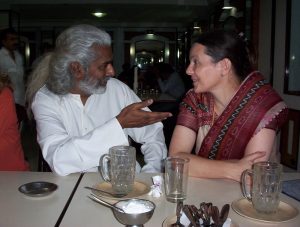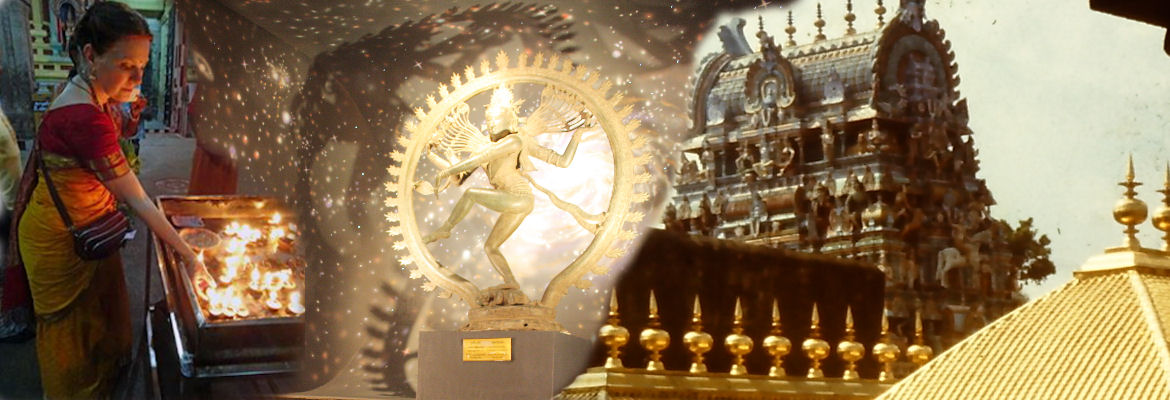
This article was written in memory of Raja Deekshithar by Liesbeth Pankaja Bennink shortly after his death on the 30th of june 2010 and published in NAMARUPA Categories of Indian Thought, 4 Issue 12 Volume 03 in 2010
“We are drifting everywhere. As long as we allow ourselves to drift He appears to be still. As soon as we make ourselves empty and silent, we can begin to see and experience His Cosmic Dance.”
These are the closing words of The Hidden Treasure in the City of Ether, Raja Deekshithar’s first book. More than any other of his many writings and works this book expresses who Raja was, what he was about and what he cared about most. The Hidden Treasure in the City of Ether is about the Shri Shiva Nataraja temple in Chidambaram. Raja was born a Deekshithar. Deekshithars are a community of spiritually dedicated people who have been the custodians of the Vedic tradition of this temple from pre-Christian times onwards. A great many books have been written about this temple, and rightly so. But Raja’s book is not about how high the towers are or when this or the other shrine was built by which king. In his book Raja shares with us the result of his own quest for knowledge about himself and about the tradition he was born in. The outcome of his asking “Why?” It was a quest he pursued with great love and respect for the tradition, but also with an astute and inquisitive mind and a deep desire for truth.
Some two and a half decades ago I came to Chidambaram in search of knowledge and with many questions on my mind. I had studied history at a university in the Netherlands, the country of my birth. I had also been trained as a Bharata Natyam dancer by Srimati Rajamani, a little known but great dancer and a wonderful teacher and guru, who had taken me under her wing, teaching me both the techniques of this dance art from South India and the traditions of which it is a part. Eager to know more I had also begun studying art-historical and Indological academic literature. This made for a strange encounter. Because, from my point of view as a dancer from within the tradition, there seemed to be a complete disconnection between the academic studies and the tradition I was being introduced to by my guru.
This was very confusing. Contacts from the academic side seemed to be convinced they knew and understood Indian tradition in the correct objective way. Even better then the people whose tradition it actually was. My guru Rajamani laughed at their perceptions and notions. I was wondering who was right. As this observation was occupying my mind one of my friends from the university told me I should go to Chidambaram and meet with Raja Deekshithar. He could answer my questions, I was told. And he sent with me some small gifts for Raja and his family.
It was my second visit to the Home of the Dancing Shiva. Some two years earlier I had visited this sacred place to have darshan of Lord Nataraja and to study the karanas, the 108 dance movements of Lord Shiva. Entering His temple had been a deeply spiritual and emotional experience, which was made even more special when my guru suggested I should dance before the Lord. To my amazement and happiness she organized this expression and offer of my devotion. On this occasion of my second visit, again Lord Nataraja showered me with His grace by way of meeting Raja.
When my guru Srimati Rajamani had first told me about the Deekshithars, their tradition, dharma and their way of life, it had sounded as if she spoke of a people from another era, a living time-capsule. The Raja I met was all that and so much more; he was past, present and future. While laughing and joking, he talked about Richard Bach and Jonathan Livingston Seagull, Kahlil Gibran and The Prophet, his favourite books. He listened to Simon and Garfunkel and quoted Shakespeare when teaching philosophy. Fun, wisdom and knowledge flowed through him all the time as though he was tuned into an inexhaustible source of cosmic spiritual energy.
He invited me to his house to meet his family, his wife, daughter and three sons, the youngest of whom was a little over one year old at the time. After a bit of talk he handed me a few typed pages and asked me to read. It was part of the manuscript which eventually became The Hidden Treasure in the City of Ether. I read and the flow of words and sentences was so smooth, my reading took just a little time. But the contents hit me deeply. After many years of bewilderment over the contradictions between my guru’s teaching and academic analysis here was somebody who brought the two worlds together and joined what was seemingly separate and disconnected into one understanding. He was scholar, academic, master, teacher, priest and devotee at the same time. He united the traditional approach, which he called Feeling Orientation, with the scientific approach, which he called Factual Orientation, and presented the mysteries of Lord Nataraja, the temple and the traditions with such clarity and directness you would not realize the complexity, profoundness and depth of his explanation while reading. By uniting the purity of devotion and faith with the clarity of research and analysis he achieved a perception and understanding which was accurate and true. He did not compromise anything, he simply was right. I was amazed and full of joy. I had found the person I was looking for.
One other thing jumped at me from these pages. He mentioned the presence of two sphinxes guarding the entrance to the temple. I had been interested in ancient culture from an early age and had never heard of Indian culture being associated with sphinxes. I was immediately intrigued and enthused about this amazing discovery. Sphinxes in an Indian temple, what did it mean? Were they related to the sphinxes from Egypt, Greece and Mesopotamia? So now I had found a great scholar who could answer my many questions, but I also found that Raja and I shared many interests. This discovery of two sphinxes in the Nataraja temple of Chidambaram would eventually lead to his project on the Sphinxes of India.
Now so many things just fell into place, not only for me but for Raja as well. For him it fulfilled his longing to connect with the West, to share his knowledge and present a true understanding of Lord Nataraja’s Cosmic Dance to the world. From my side, this connection fed my love for the dance, my devotion toward the Dancing Shiva, my thirst for knowledge and my life goal–realizing Lord Nataraja’s Dance as well as my own dance. It became one path which Raja and I walked together all these years. And this path I will continue to walk in his memory. Often the sphinx directed us along our way.
He was many things to me as I was many things to him. In one word I could say that as he made my dreams come true I made his dreams come true. My dream was to dive deep into Indian tradition and culture. His dream was to travel west and live and share among the people he felt understood and appreciated what he had to offer. We fulfilled each other’s deepest needs and longing.
Raja was unique in his energy, his depth and light. He lived with boundless compassion, always ready to help to the best of his ability. He carried within him an incredible treasure of knowledge. In a way he didn’t even know what he knew until somebody asked. He lived through his dharma, his wisdom and his devotion. He was physically beautiful, charismatic, with a genius mind, and great fun to be with. And he loved to cook. Cooking and sharing food with others was possibly his greatest joy. And in his cooking he did what he always did, respecting and treasuring his own tradition but at the same time widening his horizons and enjoying the kitchens of other cultures. He was especially fond of the Greek kitchen and of Mediterranean tapas.
He taught the importance of diving. He taught by example and analogy and it was always an adventure. I learned so many things: insight into human nature, doctrine, philosophy, art, history, yoga, healing, astrology, mythology, insight into my own being and that of others. Life with him was all about realization and self-realization. He was ever respectful of the opposite and lived with integrity and self-respect.
He was a free soul, but he always was bound by what was right, by his understanding of dharma. In essence he was truly a Jonathan Livingston Seagull, the hero of one of his favorite books. This quality was recognized in him by one of the travelers he met in the temple who later sent him the book. In spite of his many qualities, or maybe because of them, it was not easy to be Raja Deekshithar. Like Jonathan Seagull, he was unorthodox and determined and, as a consequence, he faced opposition and continuous struggle from a young age. At the age of eleven he already had to fend for himself, choosing a path of his own instead of that which his immediate family tried to force upon him.
At the same time his life was guarded by Divine Grace. Through all struggles people always came who helped him overcome the obstacles on his path. Through Divine Grace he finished school and university, followed his father’s footsteps as a priest of both Lord Nataraja and Mother Tillai Ambal, and was invited to visit Holland as a tourist. I suppose my entering his life and dedicating myself to him and his work as his student and research assistant was also part of this Divine Grace. For me it surely was and is. Divine Grace together with his incredible gifts, talents, skills and abilities made his life exceptional and unique. Without any doubt, like Jonathan Livingston Seagull, he achieved the highest degree. But the truth is that in his life-time he never reaped a proper harvest.
And just like Jonathan Seagull, Raja still is here, flying next to us saying “The gull sees farthest who flies highest.” And he too knew, like Jonathan, that he was not bone and feathers but a perfect idea of freedom and flight, limited by nothing at all. As I hold in thought an image of a shore of another time I say “Good-bye Raja. We’ll meet again.”
Liesbeth Pankaja Bennink
September 2010
